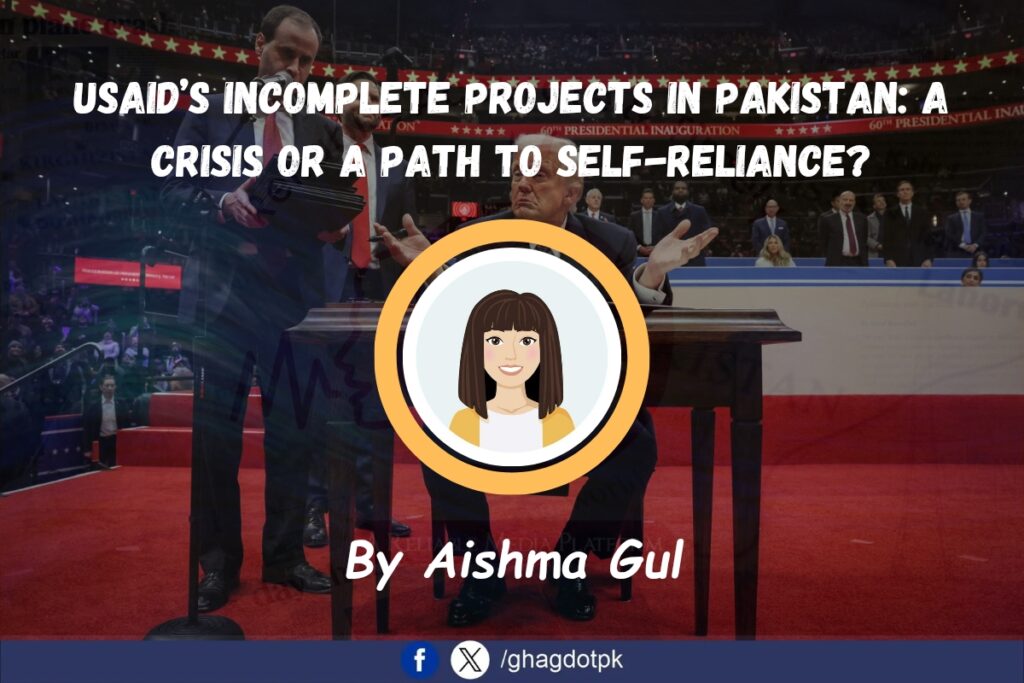By Aishma Gul
“A kite rises against the wind, not with it.”
While Pakistan struggles to focus on the abrupt end of more than $845 million worth of USAID projects in its territory, the country finds itself at a critical juncture: will the crisis push it toward the path of self-sufficiency, or reinforce its economic and social infirmities? The stakes are especially high for Khyber Pakhtunkhwa and Balochistan, provinces where USAID’s absence threatens to reverse fragile progress in marginalized communities.
USAID: A Brief Overview
Since 1961, the United States Agency for International Development (USAID) has played a crucial role in international humanitarian and developmental initiatives. It works in more than 60 countries, employing 10,000 people and financing projects that address famine, pandemics, economic development and governance. But the future of USAID is uncertain under President Donald Trump’s administration, where it has repeatedly been accused of inefficiency, wasteful spending and misalignment with “America First” policies.
Impact of USAID’s Closure on Pakistan
The suspension of USAID’s projects has created a development vacuum, with 39 halted initiatives spanning health, education, governance, agriculture, and energy. The national repercussions are serious, but KPK and Balochistan, which are already struggling on numerous systemic and equity fronts, face terrifying consequences.
1. Healthcare Crisis
Nationally, the $86 million Integrated Health Systems Strengthening and Service Delivery (IHSS-SD) Program and the $52 million Global Health Supply Chain Program have stalled, with the risk of recommencing preventable diseases.
Balochistan: Needing it most, the Maternal and Child Health Program has been suspended in the province with Pakistan’s highest maternal mortality rates. In some districts, like Khuzdar and Jaffarabad, rural clinics that depended on USAID-funded medical supplies are now dealing with dire shortages.
KPK: Anti-polio campaigns in conflict-affected districts such as Bannu and Lakki Marwat, partially supported by USAID, may struggle to meet targets, risking outbreaks.
2. Education Setback
The $30.7 million Merit and Needs-Based Scholarship Program, which supported underprivileged students, has been put on hold.
KPK: The $40 million Promoting Quality Education Program, designed to rebuild schools in Swat and Bajaur, remains unfinished, leaving 200,000 students in limbo.
Balochistan: The closure of USAID-backed literacy centres in Quetta and Turbat disproportionately impacts girls, who constitute 70% of beneficiaries.
3. Economic and Governance Challenges
A $15 million initiative, the Inclusive Democratic Processes and Governance Project —designed to improve transparency — has grounded.
KPK: The Sub-National Governance Program, which trained local officials in fiscal management in districts such as Dir and Buner, has the potential to undermine recent gains in participatory budgeting.
Balochistan: Agricultural modernization initiatives through the $25 million Balochistan Agriculture Project, which are vital for farmers in Chagai and Nushki hit by drought, have come to a standstill.
Pakistan’s Response: Crisis or Opportunity?
The abrupt withdrawal of USAID funding raises critical questions: Will Pakistan pivot toward self-reliance, or will the loss of aid deepen dependency?
1. Strengthening Domestic Institutions
KPK’s Governance Experiments: Despite facing criticism over allegations of corruption and delay of projects in past initiatives, KP’s recent institutionalization experiment—Sehat Sahulat Program providing health insurance to 7.2 million families—is one such example of covering gaps in USAID healthcare support. The Citizen Feedback Program, a mobile-based system for public service monitoring, is yet another example of these efforts to digitize governance; however, implementation challenges persist.
Balochistan’s Fiscal Demands: Lawmakers advocate for revising mineral revenue-sharing agreements under the 18th Amendment to fund local development, reducing reliance on external aid.
2. Diversifying Foreign Partnerships
While China’s Belt and Road Initiative (BRI) and CPEC dominate infrastructure investments in both provinces, critics highlight gaps in social-sector alignment.
Balochistan: The Gwadar Port, part of the China-Pakistan Economic Corridor (CPEC), has led to impressive infrastructure development, but perceptions of inequity are stoked by a failure of parallel investments in healthcare and education.
KPK: The Dasu Hydropower Project, part of CPEC, could help resolve energy deficiencies caused by halted USAID power initiatives, though concerns about debt sustainability persist.
3. Promoting Indigenous Solutions
Balochistan: NGOs such as the Balochistan Rural Support Program (BRSP) registered by the Pakistan Centre for Philanthropy are increasing the coverage of their microfinance schemes for women-led agribusinesses. In Mastung and Kalat, traditional water conservation strategies such as the rehabilitation of karez systems are being revived.
KPK: Tech-driven initiatives like Pehlaaj, a Peshawar-based e-learning platform developed by local engineers in 2021, aim to bridge education gaps.
The Road Ahead: Challenges and Uncertainties
While the USAID freeze poses immediate risks, long-term implications hinge on Pakistan’s response:
1. Short-Term Instability: Job losses due to suspended projects like USAID’s energy initiatives in KPK’s Kohistan and solar energy programs in Balochistan will add to unemployment.
2. Security-Development Nexus: In KPK’s Deradicalization and livelihood projects stalled in KPK’s Swat Valley and Balochistan’s Makran Division risk reigniting militancy.
3. Institutional Capacity: Provincial governments in KPK and Balochistan must address bureaucratic inefficiencies to mobilize domestic resources effectively.
The USAID crisis is a litmus test for Pakistan’s self-reliance. But Pakistan can transform this crisis into an opportunity — by concentrating on self-sufficiency, governance reforms, and diversified partnerships. But inaction could exacerbate economic and social vulnerabilities, extending the country’s reliance on foreign assistance.
The choice is clear: Rise like a kite against the wind, or stay stuck in the storm!






